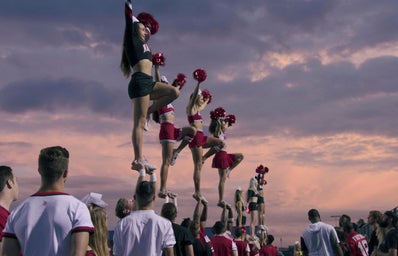Friends, Romans, countrymen, I am begging you to watch Cheer on Netflix.
When I returned to college after winter break, I quickly began hearing buzz about a new documentary series covering a cheer team. I brushed it off at first; I have to admit, I have never been a fan of cheerleading. I grew up watching ballet, and though I admired the difficulty of cheer, it seemed to me so empty and one-dimensional in comparison. But last week, while in bed with a cold and avoiding homework, I decided to give the show a chance, and I am so glad that I did.
Cheer is not a reality show; the drama feels too real to be “reality,” and according to the cast, all of it is. The tone is decidedly sincere, and every “character” feels less like a character than a multifaceted person. We learn about the cheerleaders’ (often tragic) childhoods and really get a chance to understand how their pasts shape the people they are today. The show is shot beautifully and artistically; images that people outside the cheer world might consider trashy (spray tans, raves, bedazzled costumes, rural Texas) are made elegant. The lens through which Cheer is filmed is critical, but never mocking.

Still, it’s hard to completely support everything that goes on at Navarro Community College, the school at the heart of the show. These young athletes are pushed to their limits in ways I’ve never seen before. They continue their routines through terrifying falls and serious injuries (including one cheerleader who gets her fifth concussion during the filming of the series). The female members of the team express stress and concern over maintaining the “right” body type, trying to diet even while exercising themselves to exhaustion every day. The cheerleaders seem to realize that cheer destroys the body (as do many other sports). Is it worth it, the show asks, considering the hopelessness of a career in cheer after college? To the cheerleaders at Navarro, it is worth it; their sometimes blind devotion to the sport is compelling.

One aspect of the show I found particularly interesting was its sociological analysis of the concept of a “cheerleader.” Throughout the series, an author of a book on the history of cheerleaders provides commentary and context. Traditionally female, white, and conventionally attractive, cheerleaders were expected to bring joy–sorry, cheer–to all those around them. They had to stay “beautiful” and happy in order to keep athletes motivated. Today, cheerleaders are athletes and have become the center of attention of their own events, but the need to be conventionally attractive, smile constantly, and look “put-together” remains (particularly for female cheerleaders). This combination of extremes in athleticism and aestheticism makes modern-day cheerleading a unique experience, and an incredibly challenging one.
I believe it’s truly impossible to get through Cheer without becoming emotionally attached to multiple, if not all, of the young cheerleaders it follows. Yes, they can perform feats that appear inhuman to a non-athlete like myself, but they’re also students, friends, sons, and daughters.


